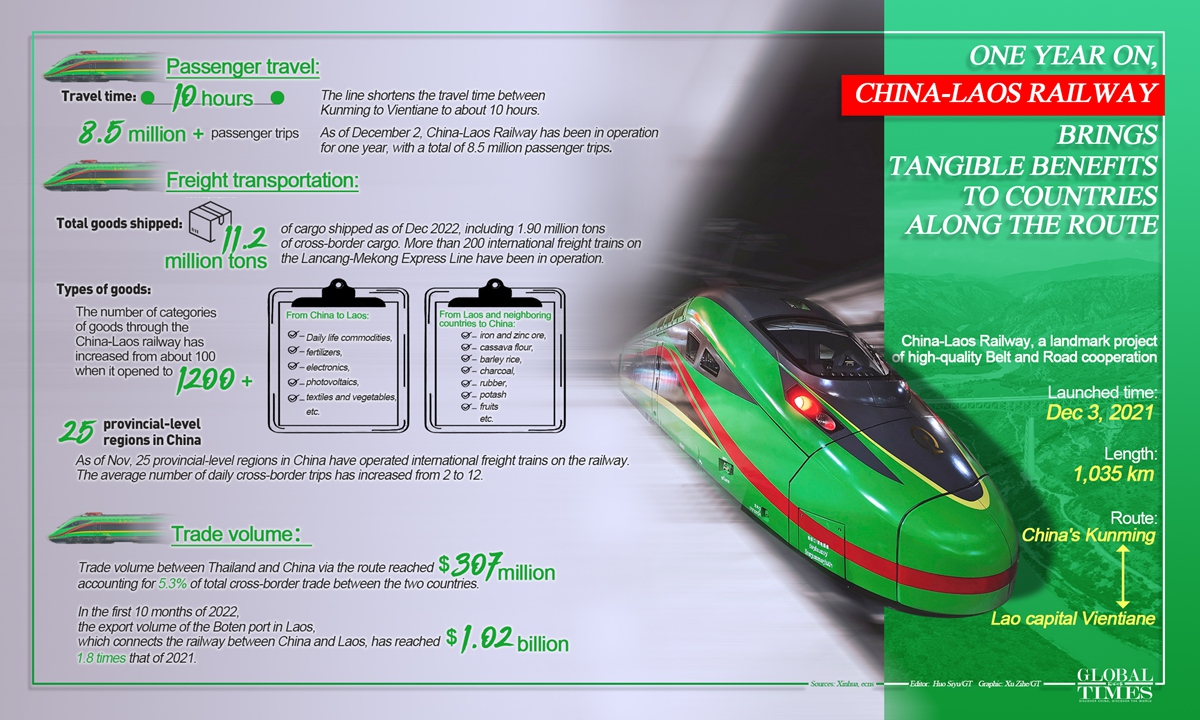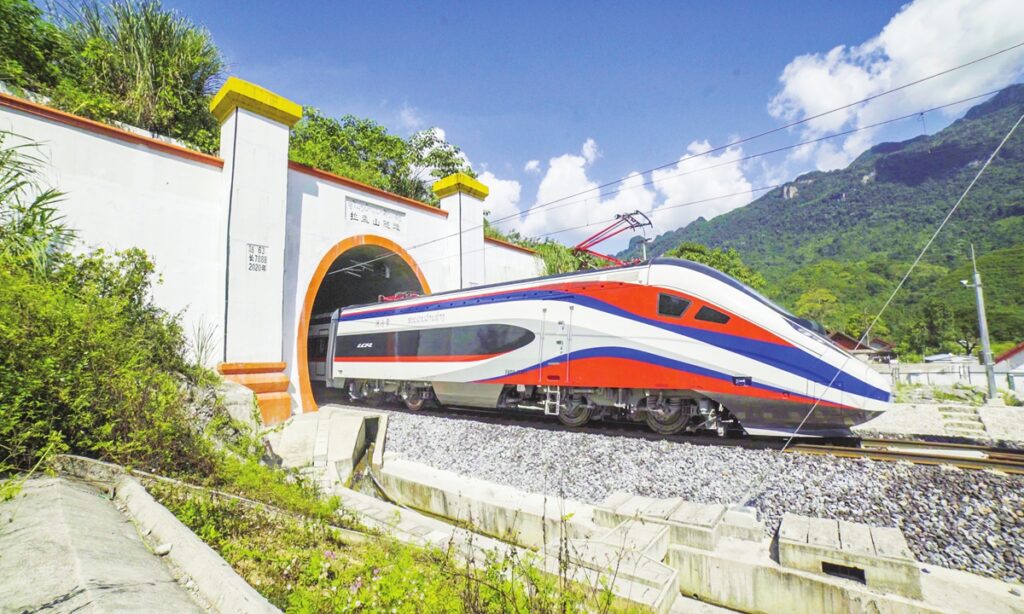Mega connectivity project creates 100,000 jobs, carries 11.2 million tons of cargo and 8.5 million passengers
As the China-Laos Railway celebrates its first full year in service on Friday since going into operation, the 1,035-kilometer-long milestone project has created a bright path for developing the local economy and improving the livelihoods of people along the route under the China-proposed Belt and Road Initiative (BRI).
The railway’s inclusiveness, its contribution to the local community along its route and the level of enhancement it has brought to the Lao people also served as a strong rebuke to some Western media’s biased views, which described the railway as a “debt trap” and a violation of human rights, or as something that would benefit China and Thailand more than Laos, Chinese experts noted.
A joint statement was released on Friday following the meeting between the leaders of China and Laos on Wednesday. It said the two sides will continue to work together to build a high-standard, high-quality and high-level China-Laos community with a shared future, and make positive efforts and demonstrations for the building of a community with a shared future for mankind.
The two sides agreed to actively negotiate new action plans and deepen cooperation in fields including political security, pragmatic cooperation and ecology.
In the official joint statement, the China-Laos Railway has been described as a “road of happiness, development and friendship” for the people from the two countries, generating great benefits for the two sides and injecting strong impetus into regional peace, stability, development, and prosperity.
The joint statement further stressed the strengthening of the high-quality operation and safe management of the railway, while continuously promoting the construction and progress of the China-Laos Economic Corridor and other projects.
Following the implementation of the Regional Comprehensive Economic Partnership (RCEP) in January, the successful operation of the China-Laos Railway has provided an indispensable transportation option for meeting surging market demand, especially between China and ASEAN members.
The railway has carried 11.2 million tons of cargo as of Friday, according to a statement sent to the Global Times by China Railway.
The statement added that the cargo categories have expanded from around 10 types of goods in the early stage of opening to more than 1,200 kinds of electronics, photovoltaic, and cold chain-fruits among others, with the total delivered cross-border cargo volume exceeding 1.9 million tons and covering multiple countries and regions such as Thailand along the BRI route.
The China-Laos Railway has stepped up the linkage with the China-Europe freight trains and the New International Land-Sea Trade Corridor trains, establishing innovative transportation models.
The first dedicated train carrying 5.5 million yuan ($780,000) worth of cold-chain Thai fruits to Southwest China’s Chongqing Municipality from Vientiane in Laos and which will enter China through the Boten border gate departed on Friday, marking a new “Thailand-Laos-Chongqing” route.
The exchange and flow of resources and local economic development has been further boosted by more frequent and elevated trade contacts.

One year on, China-Laos Railway brings tangible benefits to countries along the route.Graphic: Xu Zihe/GT, Editor: Huo Siyu/GT
Chinese experts expounded that the first full-year operation of the railway, in terms of both the scale and depth of cooperation, has fully demonstrated its economic value not only to Laos, as the country now becomes a land-linked hub, but also to neighboring countries.
The production of iron ore, cassava flour and rubber in Laos has increased by 1.8 million tons, 2 million tons and 1 million tons respectively, compared with a year ago. And 23 new related enterprises have been established.
From January to October in 2022, the export trade volume at the Boten border gate, linking the railroads of China and Laos, reached $1.024 billion, 1.8 times that of 2021, showing that the railway has injected surging momentum into the economic and social development of Laos.
As more businesses explore the huge potential along the rail line, local residents are able to make the most out of these business visits by offering services and selling products.
Following the operation of the China-Laos Railway, villagers have been able to generate income by setting up small roadside stalls, restaurants and even hotels at Vientiane Railway Station, with more investors coming to check out the village, Vieasim, deputy governor of Dong Pho Si Village, Beach Phong District in Vientiane, told the Global Times.
“Thanks to China, the Laos-China Railway has brought us real and visible benefits,” Vieasim said.
In addition to the tangible benefits resulting from strengthened trade and business opportunities, the construction and operation of the railway has stimulated the local tourism economy. The railway also became a top transportation option for commuting thanks to its efficient and comfortable travel experience.
Thinnavat, 29, works for the Laos-China Railway Company, and has witnessed the entire construction process and operation of the railway. He is from Luang Prabang, an important tourist city in northern Laos, and his wife is from Vientiane.
He noted that they used to have to take a 12-hour bus ride to visit each other’s parents, whereas now it only takes two hours on the Lancang EMU, which is a convenience that the Laos-China Railway has brought to many ordinary Lao people.
The China-Laos Railway has seen a total of 8.5 million passenger trips in the first year of its operation, according to the report from China Railway.
The statement noted that the Chinese section operates 42 daily trains with the maximum capacity reaching 65 for 50,000 people, sent 7.2 million passengers in total.
The six lines in the Laos section have transported 1.3 million passengers.
The report added that 85 percent of tourists choose to travel from Vientiane to Luang Prabang by train, promoting the rapid development of the tourism economy along the route.
The China-Laos Railway has created a large number of jobs for local residents. More than 3,500 Lao employees are working in cargo handling, logistics, security, cleaning and other sectors. Together with the development of logistics, urban transportation, commerce and trade, tourism and other industries, the China-Laos Railway has indirectly created more than 100,000 job opportunities.
The Chinese side has trained more than 1,000 Lao employees, with 700 more of them involved in the operation and maintenance of the China-Laos Railway, becoming the first generation of local railway technical personnel.
Lim, a Lao employee who works in the maintenance and management center in Luang Prabang, told the Global Times that he learned the relevant skills and technologies in China, and returned back to Laos in November 2021, and now does important jobs at the center.
(Global Times)




